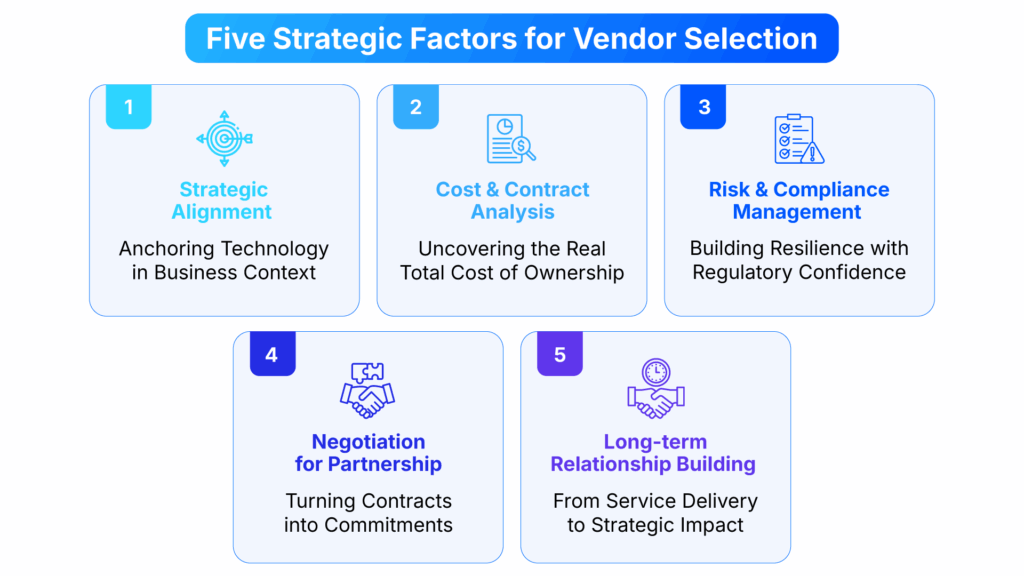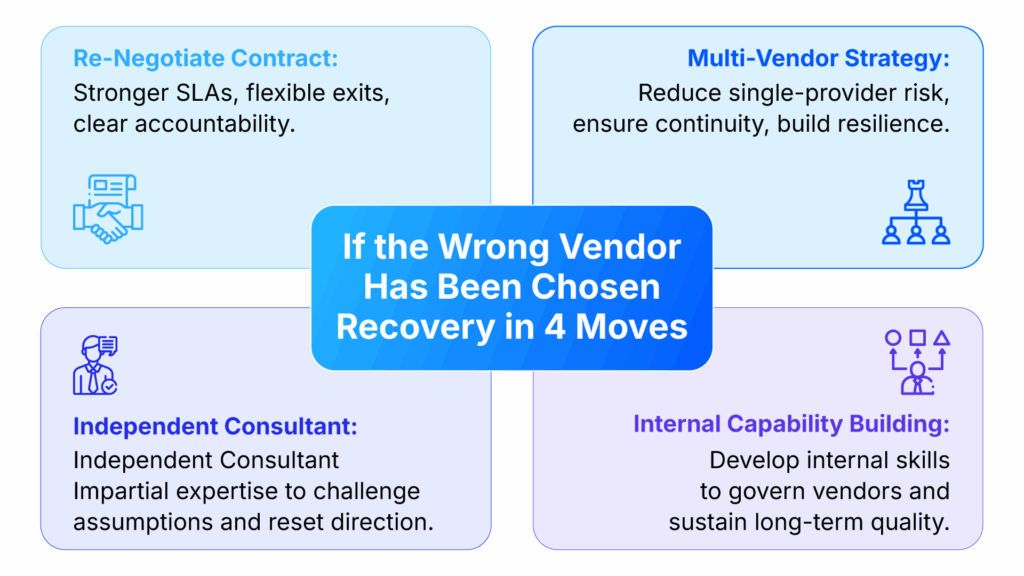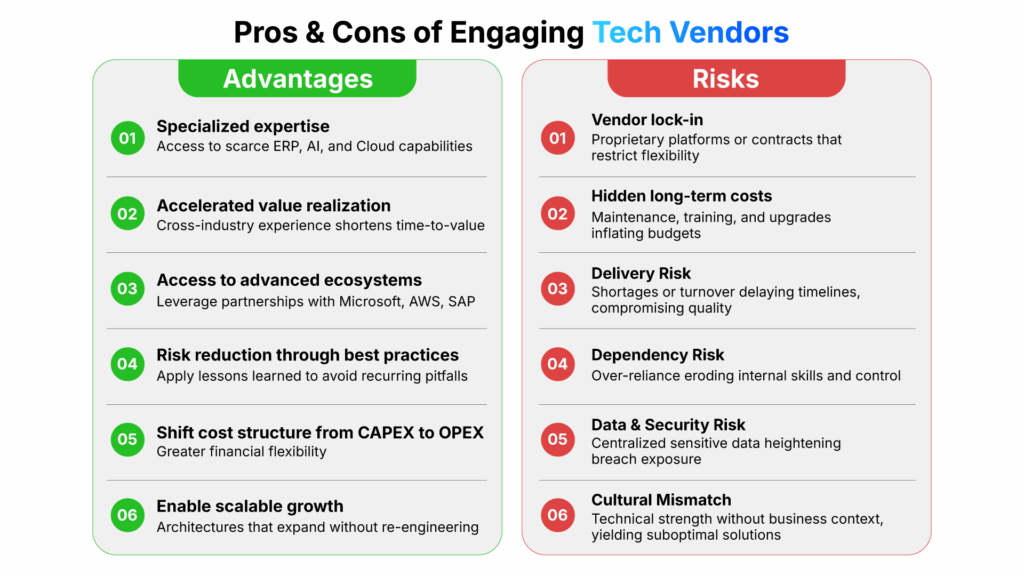Why Vendor Selection Is Not About Systems, But About Strategy?
An incorrect vendor decision can undermine digital ambitions and result in costly failure.

Disruption spares no one. Enterprises of every scale are exposed to risk the moment they fail to keep pace with the relentless acceleration of business and technology change. Digital Transformation is no longer optional; it has become a strategic imperative—vital for sustaining competitiveness and unlocking long-term growth.
Amid mounting economic pressures and intensifying market competition—where enterprises must accelerate growth, optimize costs, and secure competitive advantage simultaneously—the choice of Tech Vendor stands as a defining strategic decision. It is the decision that determines whether Digital Initiatives scale into sustainable success—or falter and collapse midway.
Why Do So Many Digital Initiatives Fail?
“Gartner (2025) reports that only 48% of Digital Initiatives ultimately achieve their intended business outcomes.”
The causes are structural rather than incidental. Common barriers include persistent misalignment between business and IT priorities, initiatives that stall in the “Pilot Trap” and fail to scale, insufficient focus on Change Management and regulatory compliance, and weaknesses in financial governance.
From Bluebik’s perspective, these risks intensify when organizations entrust their transformation to a vendor that lacks the ability to act as a trusted strategic partner. The result is often fragmented systems, escalating costs, and investments that fail to deliver measurable value. In this context, vendor selection is not merely a procurement exercise but a foundational decision—one that determines whether digital investments generate enduring enterprise value or ultimately end up as sunk costs.
Five Strategic Factors for Vendor Selection

“The first decision sets the trajectory for everything that follows.”
Vendor selection should be positioned as the pursuit of a strategic partner, not simply the acquisition of a system provider. To ensure that transformation objectives translate into successful execution, enterprises should evaluate vendors rigorously across five dimensions:
1️⃣ Strategic Alignment – Anchoring Technology in Business Context
- Technology must follow strategy. Vendors should align solutions with the organization’s roadmap—whether AI, automation, or cloud-first adoption.
To ensure impact, organizations should:- Validate with Proof of Concept (PoC) or pilots: test performance under real operating conditions
- Assess integration and readiness: compatibility with legacy environments and ability to integrate emerging technologies
2️⃣ Cost & Contract Analysis: Uncovering the Real Total Cost of Ownership
- License or subscription fees are only the tip of the iceberg—the true Total Cost of Ownership (TCO) goes much deeper.
A comprehensive assessment should:- Cover implementation & integration: deployment, migration, and system connectivity
- Prepare the workforce through training & change management: including transition costs
- Sustain long-term maintenance & support: service, patching, and upgrades
- Factor in hidden costs: downtime, vendor switching fees, and exit penalties
- Consider opportunity costs: value foregone if the vendor cannot support future strategy
3️⃣ Risk & Compliance Management: Building Resilience with Regulatory Confidence
- Cybersecurity, data governance, and compliance are non-negotiable. Vendors must prove resilience through robust frameworks.
A forward-looking assessment should:- Mitigate lock-in risks: maintain flexibility amid evolving regulations
- Validate scalability: ensure systems support growth without redundant reinvestment
4️⃣ Outcome-Based Negotiation: Turning Contracts into Commitments
- True partnership is negotiated not on cost, but on outcomes.
To secure accountability and execution excellence:- Define measurable KPIs with enforceable penalties
- Leverage performance-linked incentives for timely, high-quality delivery
5️⃣ Long-term Partnerships: From Service Delivery to Strategic Impact
- True long-term value comes when vendors co-create the technology roadmap, not just deliver services.
To sustain relevance and competitiveness, organizations should:- Evolve relationships in step with the enterprise
- Guarantee ensure readiness for future technological shifts amid technological shifts
🔧 If the Wrong Vendor Has Been Chosen

Selecting the wrong vendor can destabilize core systems, drive cost overruns, and constrain scalability. The consequences extend beyond operations, undermining both strategic momentum and competitive positioning.
Yet recovery is possible. With a disciplined remediation plan, enterprises can strategic levers:
1️⃣ Re-Negotiation of Contracts – Rebalancing Commitments
Strengthen SLAs, tighten performance standards, and introduce flexible exit clauses. These measures reduce over-dependence, mitigate lock-in risk, and create leverage for improved accountability.
2️⃣ Multi-Vendor Strategy – Diversification for Resilience
Mission-critical platforms such as ERP or cloud infrastructure should not rest on a single provider. A multi-vendor model enhances continuity, reduces exposure to systemic failure, and fosters competitive discipline.
3️⃣ Independent Consultants – Leveraging Objective Expertise
External advisors bring impartial perspective, challenge entrenched assumptions, and identify alternative pathways more closely aligned with business strategy. Their objectivity accelerates recovery and reduces the risk of repeating past errors.
4️⃣Internal Capability Building – Reinforcing In-House Governance
Investing in internal expertise—both technical and vendor management capabilities —creates a stronger foundation for oversight. Performance dashboards and service management tools can provide transparency, ensuring delivery remains aligned with long-term objectives.
Pros & Cons of Engaging Tech Vendors

Engaging technology vendors can unlock significant value—but also exposes enterprises to structural risks. Clear-eyed assessment of both is critical to making balanced, defensible decisions.
Vendor selection is more than a procurement exercise—it is a strategic decision that shapes the path of transformation.
The real cost of Digital Transformation is not measured by initial investment, but by a vendor’s ability to deliver resilience, scalability, and lasting competitiveness. The right choice creates a return on future value, generating sustainable enterprise value. The wrong choice risks undermining progress and reducing impact.
Ultimately, success is determined not only by visionary strategy, but by rigorous execution and the caliber of partners entrusted to deliver it.
Bluebik: Your Strategic Partner in Transformation
Choosing the right vendor lays the foundation. A robust Strategic PMO provides the engine that drives initiatives to successful completion. Bluebik is uniquely positioned to be that partner — ensuring every step of your transformation journey delivers measurable outcomes and long-term value.
☎ +66 (0)2-636-7011
📌 Reference
- Gartner (2025): Only 48% of Digital Initiatives Achieve Success — Tech Monitor










![Thumbnail [Post Event] HOW](https://bluebik.com/wp-content/uploads/2025/12/Thumbnail-Post-Event-HOW.png)

